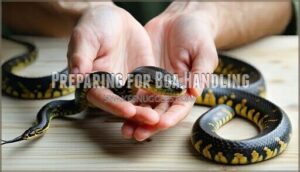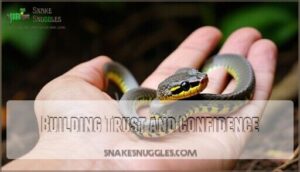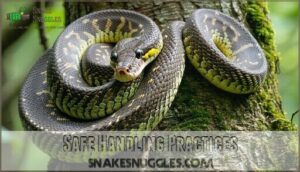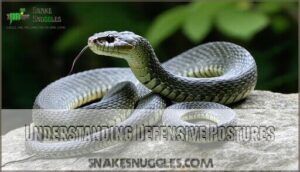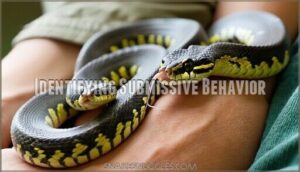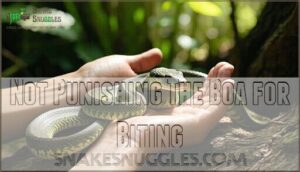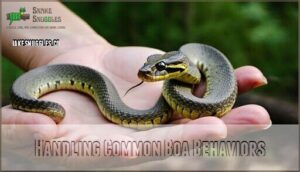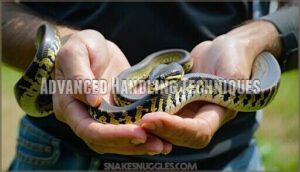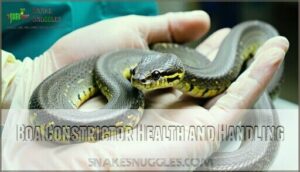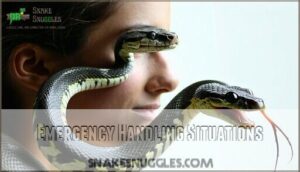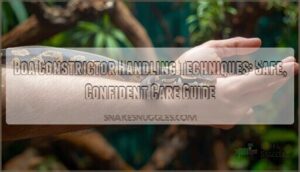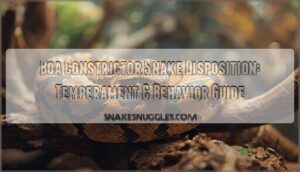This site is supported by our readers. We may earn a commission, at no cost to you, if you purchase through links.
 Handling a boa constrictor is all about confidence, patience, and understanding your snake’s body language.
Handling a boa constrictor is all about confidence, patience, and understanding your snake’s body language.
Always start slow—wash your hands to remove scents, and approach with steady movements. Use a snake hook for initial contact, especially with larger boas, to avoid startling them.
Support their body fully; they don’t like feeling like they’re dangling. Never handle after feeding or during shedding—they’re moody then, like anyone skipped their coffee.
Watch for signs of stress, like fast tongue flicks or a tight coil. The key is consistency and reading their cues.
Curious about building trust? Stay tuned for tips on overcoming head shyness!
Table Of Contents
- Key Takeaways
- Preparing for Boa Handling
- Initial Handling Techniques
- Building Trust and Confidence
- Safe Handling Practices
- Boa Constrictor Body Language
- Face Training and Bites
- Handling Common Boa Behaviors
- Advanced Handling Techniques
- Boa Constrictor Health and Handling
- Emergency Handling Situations
- Frequently Asked Questions (FAQs)
- How do you handle a boa constrictor?
- Are boa constrictors safe?
- How do you care for a boa constrictors snake?
- How do you handle a boa?
- How do you know if a boa constrictor is healthy?
- What should an adult boa constrictor be fed?
- Do boa constrictors like to be handled?
- What to do if a boa is constricting you?
- Are boas good for handling?
- Do I need to handle my boa constrictor?
- Conclusion
Key Takeaways
- Always wash your hands with unscented soap and use a snake hook for initial contact to avoid startling your boa or triggering a feeding response.
- Handle your boa when it’s calm and alert, avoiding times like shedding or within 48–72 hours after feeding.
- Support your boa’s body fully during handling and watch for stress cues like hissing, rapid tongue flicking, or tight coiling.
- Build trust with regular short sessions, using consistent pre-handling routines and slow, steady movements to establish a feeding response.
Preparing for Boa Handling
You’ll need to set the stage properly before your boa slithers into your arms, just like you wouldn’t jump into a pool without checking the water first.
Proper preparation includes washing your hands with unscented soap, waiting until your snake is awake and alert (not during shedding or after feeding), and using a gentle tap with a hook to signal that handling time—not dinner time—is about to begin.
Wash with unscented soap, wait until alert, and tap gently to signal it’s handling time—not dinner time!
This preparation is crucial because it ensures your snake is ready for interaction and reduces the risk of misinterpreting your actions, allowing for a safe and enjoyable experience for both you and your boa.
Choosing The Right Time to Handle
Choosing the right time to handle your boa constrictor substantially impacts both your safety and the snake’s stress levels.
For best results, observe your boa’s:
- Shed cycle – never handle during "blue" phase when eyes are cloudy
- Digestion status – wait 48-72 hours after feeding
- Activity level – handle when alert but calm
Wait until evening hours when boas are naturally more active. New enclosure? Give them a week to adjust before handling. Watch for individual temperament signs like relaxed body posture and curious tongue flicking that indicate readiness for interaction.
Washing Hands Before Handling
Now that you’ve chosen the perfect time to handle your boa, hand hygiene comes next. Always wash your hands thoroughly with antibacterial soap and warm water for at least 20 seconds before touching your snake.
This simple step serves two important purposes: scent removal and pathogen prevention. Your hands carry many smells that might confuse your boa or trigger a feeding response.
Proper hand hygiene also protects against salmonella transmission between you and your pet. If soap isn’t available, use hand sanitizers in a pinch, but remember they don’t remove all scents.
Some handlers prefer unscented soaps to maintain a consistent scent their snake recognizes. Snake handling safety starts with clean hands!
Signaling Handling to The Boa
Now that your hands are clean, it’s time to let your boa know you’re ready for handling time. Just as knocking signals your arrival at someone’s door, proper signaling helps prepare your boa for interaction.
Tap the snake gently with a paper towel roll or snake hook before picking it up. This consistent tapping technique distinguishes handling time from feeding time, reducing the chance of defensive strikes. Remember that consistent tap training can inhibit feeding responses.
Consistent taps signal your boa it’s handling time, not feeding time—building trust while reducing the risk of defensive strikes.
- Use 2-3 light taps on the mid-body region
- Keep your movements slow and deliberate
- Maintain a consistent pre-handling routine
- Allow your boa a moment to recognize your presence
- Watch for tongue flicks indicating awareness
This simple snake handling technique creates a predictable pattern that helps your boa understand your intentions, making handling less stressful for both of you. By following these steps, you can establish a safe and enjoyable handling experience for your boa.
Initial Handling Techniques
When you first start handling your boa constrictor, it’s important to focus on keeping the process calm and controlled.
Using tools like a snake hook and supporting the snake’s body properly helps reduce stress for both you and your snake—because nobody likes a startled boa!
Using a Snake Hook for Initial Handling
Using a snake hook is a smart way to ease into boa constrictor handling without startling it.
A good hook is your best ally—choose sturdy material, match the hook size to your snake, and use a gentle tapping technique to signal handling time.
Many handlers purchase a quality reptile hook for secure handling.
- Avoid quick movements; lift safely.
- Signal with taps near the neck.
- Keep the hook steady but kind.
- Stay calm while gauging temperament, which is crucial for a successful interaction.
Supporting The Boa’s Body
After shifting from the snake hook to your hands, focus on even weight distribution.
Support your boa’s body with a loose grip, letting it wrap around you securely like a climbing vine.
Avoid tension—boas feel safest when stable.
Keep movements slow and steady.
Proper body support guarantees relaxed boa constrictor handling, making interactions smoother.
Safe snake handling techniques always prioritize comfort.
Handling for Short Sessions
Start handling your boa constrictor with short sessions, about five minutes every couple of days. It’s like easing into a new friendship—slow and steady wins trust.
- Use positive reinforcement (gentle touch, calm energy).
- Monitor its behavior for signs of stress (hissing, coiling tightly).
- Keep sessions calm to avoid overstimulation.
- Gradually increase duration weekly.
- Maintain safe handling techniques throughout.
These steps are crucial for building trust and ensuring a safe handling experience for both you and your boa constrictor.
Building Trust and Confidence
Building trust with your boa constrictor takes patience, consistency, and a gentle touch.
It’s like making friends with someone shy—small, calm gestures go a long way in helping them feel safe.
Gradually Increasing Handling Time
Think of increasing handling time like adding spice; a little at a time works best.
Gradual changes build trust while respecting your boa’s unique temperament. Add a minute or two per session and watch their comfort levels grow.
If your boa seems relaxed, you’re on the right track. If not, adjust!
- Start slow: Increment handling milestones cautiously.
- Watch for stress: Comfort first, always.
- Keep sessions consistent: Regularity equals reliability.
Handling Frequency and Consistency
Consistency is king when handling boa constrictors. Stick to a routine—short sessions, steadily increasing over time. Use this schedule to build trust without overhandling.
Here’s a quick guide:
| Frequency | Session Duration | Key Tip |
|---|---|---|
| 2–4 times weekly | 5–10 minutes | Gradual increase in time |
| 1+ months owning | 10–15 minutes | Avoiding overhandling |
| When confident | 15–20 minutes | Recognizing limits |
| Stress signals | Pause handling | Observe before continuing |
Overcoming Head Shyness in Boas
Building confidence with your boa starts with gentle touches. Use slow introductions—approach its head calmly without sudden moves.
Positive reinforcement, like speaking softly, helps. Consistent interaction is key; let your boa associate your face with safety during handling.
Over time, even head-shy boas may relax. Patience pays off—you’ll enjoy a more trusting, confident snake companion with these snake handling tips.
Safe Handling Practices
Handling a boa constrictor safely means knowing when to step in and when to step back, especially during shedding or after meals.
Watch for signs of stress, like hissing or tight coiling—it’s their way of saying they need a timeout.
Avoiding Handling During Shedding
Shedding is a sensitive time for your boa constrictor, so avoid handling to reduce stress and prevent complications.
When your snake’s eyes turn cloudy and skin dulls, it’s entering its shed cycle stages.
Instead of handling, focus on these alternatives:
- Boost enclosure humidity to aid shedding.
- Monitor snake stress factors like defensive behavior or hiding.
- Make certain handling time resumes only after a successful shed.
- Inspect post-shed skin for completeness to prevent potential issues.
Respect your boa’s needs, and shedding will go smoothly!
Not Handling a Hungry or Full Boa
After feeding, your boa needs peace. Handling a hungry or full boa can lead to bites, stress, or even regurgitation. Hungry boas may mistake hands for food due to their feeding response—ouch! Once fed, digestion discomfort and post-meal stress make handling a no-go.
Here’s the smart move:
- Stick to a feeding schedule—weekly or biweekly—reducing hunger cues.
- Wait 48 hours post-meal for safe snake handling.
- Respect digestion time to avoid regurgitation risk.
- Watch snake behavior for readiness signs before interaction.
Your patience builds trust, prevents problems!
Recognizing Signs of Stress and Aggression
Handling a stressed boa constrictor can feel tense, but their body language offers clues.
Look for defensive coiling, rapid flicking, hissing sounds, or erratic movements—clear warnings of discomfort.
Body tension and jaw locking signal aggression, while flattening out shows fear.
Ignore these stress signs, and you risk a strike.
Stay calm, move slowly, and respect their space to ease snake aggression.
Boa Constrictor Body Language
Understanding your boa constrictor’s body language is like learning a new form of silent communication, essential for keeping both of you safe and stress-free.
From defensive hissing to curious tongue flicks, your snake’s movements reveal exactly what it’s feeling—if you know what to watch for, and this can be considered silent communication.
Understanding Defensive Postures
Recognizing defensive postures is key to safe boa constrictor handling.
When your boa coils its body tightly and raises its head, it’s flashing a “back off” signal.
Hissing signals an audible warning, while tail rattling mimics a rattlesnake’s alarm.
Defensive strikes may follow if these cues are ignored, so stay calm and observant.
Understanding snake behavior helps you avoid harm and stress.
- Coiling behavior: A defensive, strike-ready stance
- Raised head: High alert and wary
- Hissing signals: Warning to stay away
- Tail whipping: Another clear defensive gesture
Recognizing Signs of Excitement or Fear
Snakes have their own way of talking, and boas send clear messages through their body language. Fast tongue flicking? That’s curiosity or heightened awareness. A stiff body with muscular tension paired with hissing signals fear or defensiveness. Notice rapid breathing changes? Your boa might be stressed.
Here’s a quick guide:
| Signal | Meaning | What to Do |
|---|---|---|
| Twitchy movements | Stress or fear | Stay calm, move slowly |
| Coiling behavior | Security or defense | Support the body evenly |
| Hissing signals | Defensiveness | Give space, approach cautiously |
Honoring these signs keeps you both safe during snake handling!
Identifying Submissive Behavior
Your boa’s relaxed posture and slow movements are signs it trusts you.
Watch for lazy tongue flicks and gentle, calm breathing—these show curiosity, not stress.
A boa lying with its body uncoiled or loosely wrapped around you is feeling safe.
Learning to read your snake’s temperament through snake body language makes boa constrictor handling less stressful and helps you understand its submissive behavior better.
Face Training and Bites
Helping your boa get used to your face is important for building trust and preventing defensive reactions.
While bites can happen, staying calm and using the right techniques will keep everyone safe and stress-free.
Teaching The Boa to Recognize The Face
Face training isn’t about selfies—it’s about trust. Let your boa constrictor associate your face with safety over time.
- Scent Association: Keep hands clean and scent-free.
- Visual Cues: Let it observe your face without startling movements.
- Positive Reinforcement: Stay calm, reward patience.
- Gradual Introduction: Allow gentle climbs without forcing.
- Avoiding Startling: Stay relaxed; sudden moves can frighten.
Understanding how to read facial muscle movements can help you better gauge your boa’s comfort level. Patience turns curiosity into trust!
Preventing and Responding to Bites
Avoid food smells and use handling gloves to sidestep bites.
Recognize signals like hissing or tight coiling—these mean “back off.”
If bitten, apply snake bite treatment immediately: clean with soap, rinse, and bandage.
Snake safety isn’t just about prevention; it’s reacting wisely.
First aid helps, but staying calm keeps both you and your boa secure.
Not Punishing The Boa for Biting
When a snake bites, it’s not out of spite—it’s instinct. Bites often come from fear, hunger, or confusion, so punishing your boa doesn’t help.
Instead, focus on behavioral understanding and trust building. Gently dislodge a biting snake with water or a soft object, avoiding punishment.
Use positive reinforcement to modify snake behavior over time. Defensive postures, like hissing or coiling, signal stress.
Learning snake handling techniques and practicing snake bite prevention keeps both you and the boa calm. Handle safely to foster trust.
Handling Common Boa Behaviors
Understanding your boa’s behavior is key to building trust and handling safely. From curious exploring to occasional stubbornness, knowing what to expect helps you stay prepared and stress-free.
Exploring and Investigating Environments
Creating an enriching snake handling environment keeps your boa curious and content. With the right enclosure setup, you’ll boost its natural instincts while making exploration safe and fun.
Add Environmental Complexity and surprise your snake with Habitat Stimulation and variety.
Try these tips:
- Introduce Novel Objects like smooth branches or textured hides for enrichment.
- Add scents, like natural herbs, for gentle Scent Introduction to spark curiosity.
- Rearrange their snake environment often, ensuring thermal and humidity needs align.
A well-prepared snake handling enclosure promotes confidence and reduces stress! Remember that environmental factors impact behavior.
Recognizing and Managing Escaped Boas
Lost your boa? Your best bet is staying calm.
Start by searching common spots—under furniture, inside vents, or near warmth like electronics. To track movement, sprinkle powdered sugar on the floor.
When spotted, use slow, steady movements for safe capture. Secure it back in its enclosure, then inspect for escape points—weak latches or gaps.
Consider snake enclosure security for added peace of mind. Review your escape prevention strategy, and make certain the habitat’s secure to avoid repeat escapes.
Escaped boas are sneaky, but smart planning wins!
Advanced Handling Techniques
When handling larger or more challenging boas, you’ll need to step up your skills to guarantee safety for both you and the snake.
Advanced techniques, like proper support and calm restraint, make managing these powerful reptiles stress-free and smooth.
Handling Large or Aggressive Boas
Handling large or aggressive boas can feel like juggling a big, scaly puzzle. Recognizing Aggression Indicators, like hissing or tail vibration, helps manage situations calmly.
Use Safe Handling Tools, like a long snake hook, to guide the boa without causing stress. Always practice Assisted Handling for Large Boa Restraint—having a second person guarantees safety.
Temperament Differences matter too; some boas mellow with age, while others need time.
- Keep calm, even if they hiss.
- Always have a buddy for large snakes.
- Trust your tools, not your reflexes.
- Respect their space—and their moods.
Using Restraint and Support
Mastering boa constrictor handling starts with the right mix of restraint and support. Keep calm, letting it wrap around while offering full body support, including the tail.
Use slow motions and a proper grip to maintain control without tightness. A snake hook can guide movement safely.
A useful tool can be aiding reptile handling. Stay relaxed—avoiding tension helps prevent mishaps, ensuring both your safety and your boa’s comfort.
Managing Boa Constrictors in Public
When handling boas in public, prioritize public safety and prepare thoroughly.
Use secure, ventilated enclosures that follow transport regulations. Obtain necessary permits and make certain your display is educational—explaining boa anatomy can captivate audiences.
A calm environment and proper snake handling precautions prevent accidents, while snake handling safety tips protect everyone.
Responsible displays shape community perception, making snake public handling a safe and enjoyable experience for all.
Boa Constrictor Health and Handling
When handling your boa constrictor, understanding its health is just as important as perfecting your technique.
A sick or injured boa needs gentle care, clear observation, and quick action to keep handling safe for both of you.
Recognizing Signs of Illness or Injury
Keep an eye out for signs of snake illness or injury, like lethargy, respiratory distress, or unusual swelling/lumps.
Scale abnormalities or regurgitation signs may hint at parasites, infections, or improper humidity.
Snake disease often shows in faded sheds or blistering.
Recognizing wheezing or gasping can indicate respiratory distress.
Routine health checks catch problems early, and it is essential to think of it as a scaly wellness exam—your boa will thank you!
Handling Boas With Health Issues
When your boa isn’t feeling its best, adjust how you care for it.
Overhandling can worsen stress and delay recovery. Focus on these steps:
- Limit handling to quick check-ins, letting your snake rest.
- Follow vet guidance for medication handling and care instructions.
- Use quarantine protocols to shield other pets from potential snake diseases.
- Watch for signs of stress reduction, like relaxed posture.
Your calm handling fosters a better recovery, keeping snake health the top priority.
Preventing The Spread of Disease
You’ve got to stay sharp in the area of disease prevention.
Start with handwashing importance—before and after handling, every time.
Quarantine newcomers for at least 30 days to catch issues early.
Make enclosure sanitation a habit, scrubbing surfaces regularly to banish bacteria and parasites.
Follow strict snake hygiene protocols to prevent zoonotic diseases like salmonella.
Think of yourself as your boa’s hygiene superhero—keeping their world clean means fewer health hiccups for both of you!
Emergency Handling Situations
Handling emergencies with your boa constrictor requires quick thinking and calm actions to guarantee safety for both you and your snake.
Whether it’s a surprise constriction or your sneaky boa escaping, knowing what to do can make all the difference, and having a plan for emergencies is crucial.
Responding to Boa Bites or Constriction
If a snake bite or snake constriction occurs, stay calm—panic won’t help.
Treat the bite by washing it with soap and water, applying first aid, and monitoring for infection.
For constriction dangers, gently unwind the boa starting from its tail, and never pull forcefully—it could get messy (and painful).
If needed, seek help when the situation feels unmanageable, and understanding snake behavior and staying steady guarantees successful snake bite treatment and safe snake constriction safety every time.
Handling Escaped or Loose Boas
An escaped boa can feel like chasing a noodle in a haystack, but don’t worry—you’ve got this. Start by calming your nerves and securing the area. Close every door and window to prevent further wandering.
Then, begin your search. Look for warm, cozy spaces like under furniture or inside closets. Use a flashlight to peek into hidden spots.
To lure your sly escapee:
- Set up a warm box.
- Place scented prey nearby.
- Sprinkle flour to track movement.
- Leave water sources out.
- Search quietly at night.
Escape prevention starts with secure enclosures!
Managing Boa Constrictors in Extreme Weather
Dealing with snake extreme weather? Stay prepared.
During heat waves, use fans and adjust enclosure insulation for temperature control. In cold weather, focus on proper humidity control and keeping a stable gradient.
Emergency relocation might be necessary—know your boa’s habitat needs beforehand.
Think of it like tuning a thermostat: your snake’s care depends on precision.
Planning ahead isn’t overkill—it’s survival.
Their comfort in extreme weather guarantees safe, stress-free handling for you both.
Frequently Asked Questions (FAQs)
How do you handle a boa constrictor?
Slow and steady wins the race—approach from the side, not above.
Wash your hands, use a snake hook, and support its body evenly.
Move calmly, avoid sudden actions, and limit handling to prevent stress.
Are boa constrictors safe?
Boa constrictors can be safe if you handle them properly.
They’re strong but usually calm.
Follow safety tips, like supporting their body fully and moving slowly.
Treat them with respect and you’ll be just fine.
How do you care for a boa constrictors snake?
Caring for a boa constrictor blends curiosity and responsibility.
Guarantee a secure, temperature-controlled enclosure, feed prey matching its size, maintain proper humidity, and handle gently yet confidently—like balancing trust and respect in any good relationship.
Handle these tasks with care, as they are crucial for the boa constrictor’s well-being.
How do you handle a boa?
Handling a boa takes confidence and care.
Approach from the side, not above.
Use a snake hook to lift first, then support its body evenly.
Move slowly, avoid sudden jerks, and keep sessions short—around 15 minutes.
How do you know if a boa constrictor is healthy?
They say the devil’s in the details, and a healthy boa shows clear eyes, smooth skin, normal breathing, and good appetite.
Watch for steady weight, regular tongue flicks, and active muscle movement for reassurance, which can be key indicators of a healthy boa.
What should an adult boa constrictor be fed?
Feed your adult boa constrictor frozen-thawed rats or appropriately sized rabbits, matching their widest body section.
Avoid overfeeding; offer a meal every 10-14 days.
Stick to prey that’s fresh, pre-killed, and free from spoilage.
Do boa constrictors like to be handled?
Imagine holding a boa that wraps around your arm like a cozy scarf.
While boas don’t "like" handling, regular, gentle interaction helps them tolerate it.
Watch for stress signs, and always respect their mood!
What to do if a boa is constricting you?
Stay calm—panic won’t help.
Support the boa’s body and gently unwrap it starting from its tail. If it’s around your neck, kneel down to reduce pressure.
Never pull; a boa isn’t a tug-of-war rope.
Are boas good for handling?
Boas make fantastic handling pets if you’re mindful of their needs.
They’re generally docile, but proper preparation and calm handling are key.
Think of them like heavy ropes—manageable with care, but demanding respect.
Do I need to handle my boa constrictor?
Around 70% of boa constrictors become calmer with regular handling.
You don’t have to handle yours, but doing so helps build trust and keeps them manageable.
Think of it like bonding time, not a chore!
Conclusion
Imagine this: a calm, confident boa gliding through your hands, relaxed and trusting.
Mastering boa constrictor handling tips comes down to consistency, awareness, and respect for their unique needs.
Handle them when they’re calm, always support their body, and recognize stress cues like tight coils.
With patience and care, you’ll build trust, even overcoming head shyness.
Remember, they’re creatures of habit, so steady, positive interactions matter.
You’ve got this—just watch, learn, and handle responsibly!
- https://www.reptifiles.com/snake-bite-strike-constricting/
- https://www.cs.cmu.edu/~dst/Calypso/Curriculum/08/
- https://medium.com/@ageitgey/machine-learning-is-fun-part-4-modern-face-recognition-with-deep-learning-c3cffc121d78
- https://www.understood.org/en/articles/helping-your-child-learn-to-read-facial-expressions
- https://link.springer.com/doi/10.1007/978-1-4614-4788-7_56

